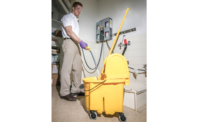Electronic mixing technology has existed for nearly 10 years in the marketplace, but to date has been limited in terms of offerings.
Only in most recent years have more selections have become readily available and pricing has become more competitive and thus reachable as additional manufacturers have jumped into the pool, as a revolution is happening before our eyes.
With the release of the ASHRAE 188 standard in June 2015, the spotlight is now shining on the topic of Legionellosis in human-occupied buildings and building water systems. Today, building owners are now faced with implementing formal programs to minimize risks associated with the potentially lethal disease.
An electronic mixing valve offers tighter temperature control than conventional thermostatic mixing technologies at plus-minus 2° F around set point. An electronic mixing valve is factory equipped to directly address the requirements of the ASHRAE 188 standard by providing multiple points of monitoring at critical locations in the building hot-water system, and can easily translate and communicate that information up to a building-management system using one of six industry standard protocols such as BACnet MSTP, BACnet IP, Modbus RTU, Modbus TCP/IP, Metasys N2 or Ethernet IP.
Finally, electronic mixing valves offer disinfection capabilities previously nonexistent in conventional thermostatic valves. It is the combination of the above technologies and the integration of them into a building water system that is fueling this revolution.
Who benefits?
The obvious and chief beneficiary of the monitoring and disinfection technologies are assisted-living facilities, nursing homes, hospitals and critical-care facilities that have large potential exposures of patients with compromised immune systems.
By using the features that come standard onboard today’s electronic mixing valves, facility managers easily can conform to the requirements of the ASHRAE 188 standard and formalize a program of risk management by providing tight temperature control, active feedback, self-balancing and remote monitoring, and even develop and perform disinfection to eradicate the potentially deadly Legionella bacteria. However, beyond just these facilities, hotels and schools could benefit from the active feedback features of today’s electronic mixing technologies.
Think about it
With the added technology there is added cost. Engineers will want to be cognizant of the target customer and decide if budgetary constraints will prohibit the selection and choice of the added cost these devices bring with them. Once the engineer has decided that electronic technology is feasible, he or she will need to size the appropriate device for the application. There are simple tools available such as manufacturer’s sizing software, which will easily allow “plug and play” of the facility type, fixture counts and allowable pressure drops to quickly size the device with interactive web links available to view all valve-pertinent data. Once the sizing is complete, engineers will need to decide on the type of configuration desired: valve only, valve with recirculation manifold or complete water temperature control station.
Valve-only configurations are the simplest option and as a result are the least expensive. These simplified assemblies often are supplied with a minimal amount of sensors and rely on the installing contractor to correctly configure the tempered return line.
The next step up is an electronic mixing valve with recirculation manifold. These assemblies are similar to the valve-only versions, but accommodations are made from the factory to simplify the installation of the tempered return line. Engineers also can choose the line size of the return connection. The final configuration type is the complete manifold system. These pre-piped units are a complete assembly containing all key elements of a domestic hot-water system. They also include optional sensors on simpler assemblies.
Down the line
The need for apps on electronic devices is growing where one could quickly and easily access, identify and monitor the key pieces of the domestic hot-water system from anywhere in the world. Bluetooth and wireless technologies are beginning to enhance the way these control devices work. As the industry grows, electronic master mixers are becoming vital pieces of the building control system. More communication is important as user safety becomes more paramount.




